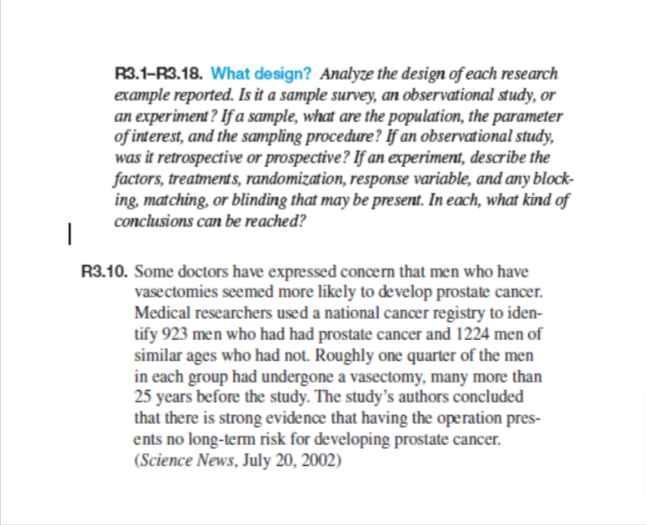R3.1-R3.18. What design? Analyze the design of each research example reported. Is it a sample survey, an observational study, or an experiment? If a sample, what are the population, the parameter of interest, and the sampling procedure? If an observational study, was it retrospective or prospective? If an experiment, describe the factors, treatments, randomization, response variable, and any block- ing, matching, or blinding that may be present. In each, what kind of conclusions can be reached? | R3.10. Some doctors have expressed concern that men who have vasectomies seemed more likely to develop prostate cancer. Medical researchers used a national cancer registry to iden- tify 923 men who had had prostate cancer and 1224 men of similar ages who had not. Roughly one quarter of the men in each group had undergone a vasectomy, many more than 25 years before the study. The study's authors concluded that there is strong evidence that having the operation pres- ents no long-term risk for developing prostate cancer. (Science News, July 20, 2002)
R3.1-R3.18. What design? Analyze the design of each research example reported. Is it a sample survey, an observational study, or an experiment? If a sample, what are the population, the parameter of interest, and the sampling procedure? If an observational study, was it retrospective or prospective? If an experiment, describe the factors, treatments, randomization, response variable, and any block- ing, matching, or blinding that may be present. In each, what kind of conclusions can be reached? | R3.10. Some doctors have expressed concern that men who have vasectomies seemed more likely to develop prostate cancer. Medical researchers used a national cancer registry to iden- tify 923 men who had had prostate cancer and 1224 men of similar ages who had not. Roughly one quarter of the men in each group had undergone a vasectomy, many more than 25 years before the study. The study's authors concluded that there is strong evidence that having the operation pres- ents no long-term risk for developing prostate cancer. (Science News, July 20, 2002)
Glencoe Algebra 1, Student Edition, 9780079039897, 0079039898, 2018
18th Edition
ISBN:9780079039897
Author:Carter
Publisher:Carter
Chapter4: Equations Of Linear Functions
Section: Chapter Questions
Problem 8SGR
Related questions
Question

Transcribed Image Text:R3.1-R3.18. What design? Analyze the design of each research
example reported. Is it a sample survey, an observational study, or
an experiment? If a sample, what are the population, the parameter
of interest, and the sampling procedure? If an observational study,
was it retrospective or prospective? If an experiment, describe the
factors, treatments, randomization, response variable, and any block-
ing, matching, or blinding that may be present. In each, what kind of
conclusions can be reached?
|
R3.10. Some doctors have expressed concern that men who have
vasectomies seemed more likely to develop prostate cancer.
Medical researchers used a national cancer registry to iden-
tify 923 men who had had prostate cancer and 1224 men of
similar ages who had not. Roughly one quarter of the men
in each group had undergone a vasectomy, many more than
25 years before the study. The study's authors concluded
that there is strong evidence that having the operation pres-
ents no long-term risk for developing prostate cancer.
(Science News, July 20, 2002)
Expert Solution
This question has been solved!
Explore an expertly crafted, step-by-step solution for a thorough understanding of key concepts.
Step by step
Solved in 2 steps

Recommended textbooks for you

Glencoe Algebra 1, Student Edition, 9780079039897…
Algebra
ISBN:
9780079039897
Author:
Carter
Publisher:
McGraw Hill

College Algebra (MindTap Course List)
Algebra
ISBN:
9781305652231
Author:
R. David Gustafson, Jeff Hughes
Publisher:
Cengage Learning


Glencoe Algebra 1, Student Edition, 9780079039897…
Algebra
ISBN:
9780079039897
Author:
Carter
Publisher:
McGraw Hill

College Algebra (MindTap Course List)
Algebra
ISBN:
9781305652231
Author:
R. David Gustafson, Jeff Hughes
Publisher:
Cengage Learning
